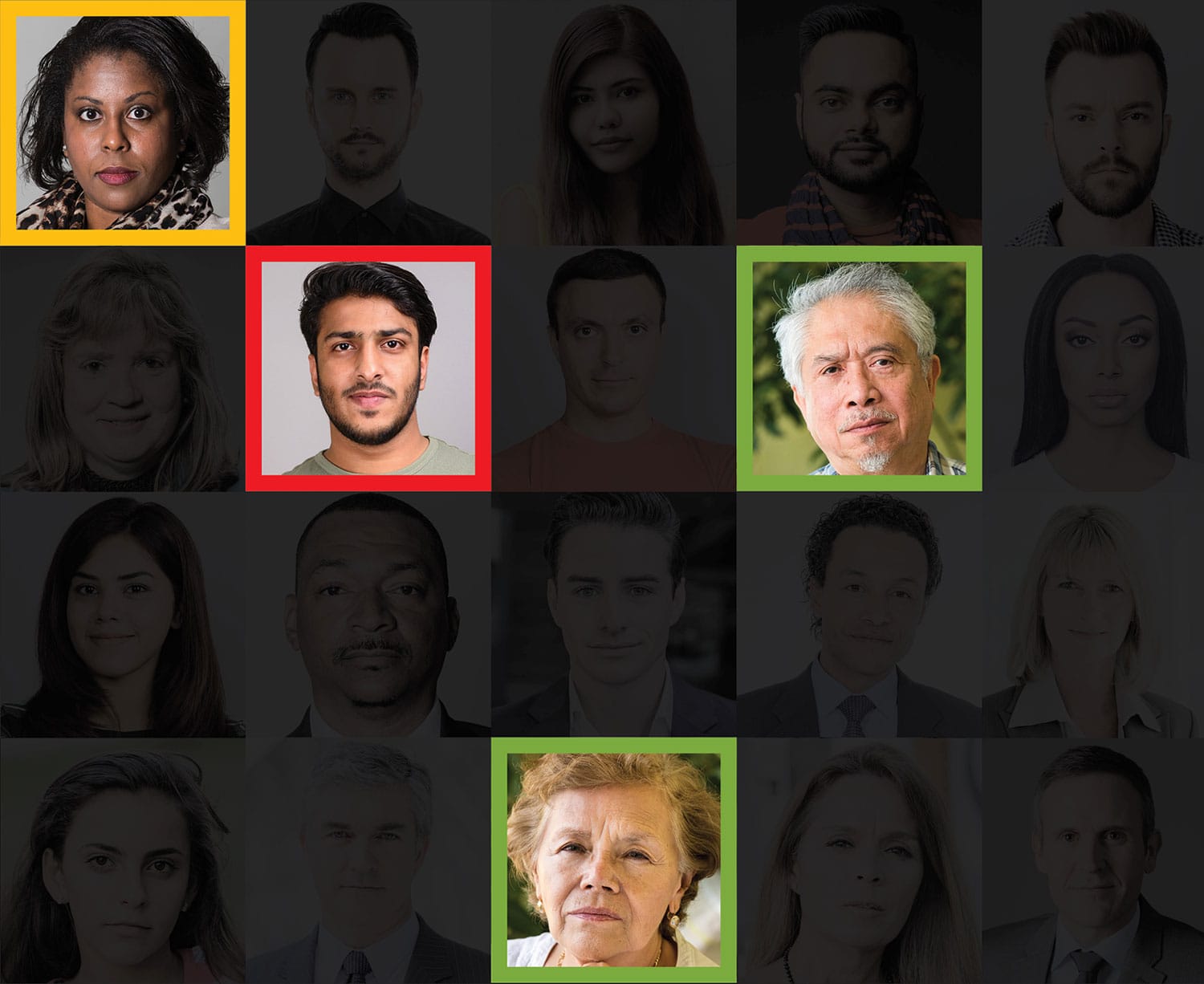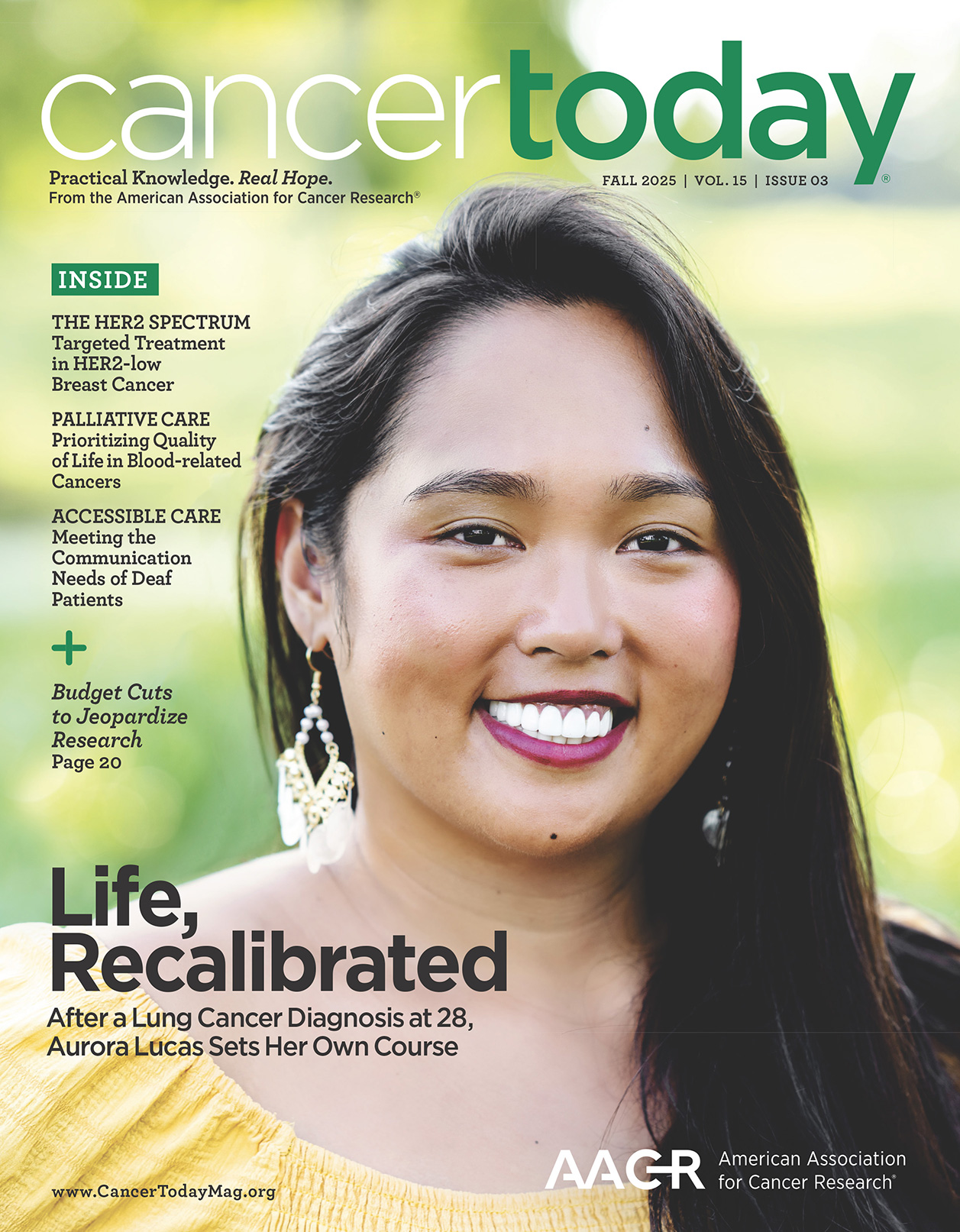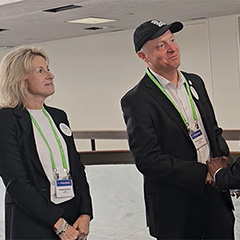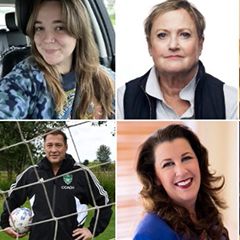MEDLINDA BACHINI, a paramedic who had regularly worked 24-hour shifts, chalked up the abdominal pain she had been feeling for a few months to too many meals out, or maybe gallstones. But on Dec. 1, 2009, the Billings, Montana, resident got alarming news. Biopsy results confirmed that the mass in her liver detected earlier with an ultrasound was a rare form of bile duct cancer.
Three weeks after receiving the diagnosis, Bachini had surgery to remove the part of her liver containing the cancerous bile ducts, which are spindly tubes that carry bile from the liver to the pancreas. Three months later, Bachini received a follow-up CT scan that brought more bad news. Cancer cells had settled in both of her lungs, where several small tumors had been found. That meant the 41-year-old mother of six had stage IV cancer, which was incurable.
Complicating matters further was that bile duct cancer, also known as cholangiocarcinoma, is a rare condition, diagnosed in only about 8,000 Americans each year. Bachini’s oncologists at the Montana hospital where she initially sought treatment told her that they had treated only a few patients with cholangiocarcinoma—and none had survived more than two years.
Like many rare cancers, bile duct cancer has no standard menu of treatment options if surgery to remove the cancer proves unsuccessful. With the future of her children, ranging in age from 7 to 20, weighing on her mind, Bachini asked her oncologist if she could explore aggressive experimental treatments in hopes that a new drug would give her the chance to see her children grow older. Her doctor’s search turned up only one clinical trial, but her health insurance company wouldn’t cover the study’s routine care costs, so Bachini decided it wasn’t an option. (This occurred before the Affordable Care Act’s mandate took effect in 2014 that requires most health insurance plans to cover routine costs for patients participating in clinical trials.)
In June 2010, Bachini started on a chemotherapy regimen that included gemcitabine and cisplatin to stall the cancer’s growth and ease her symptoms. However, she stopped taking cisplatin after six months due to side effects, including painful tingling in her hands and feet, hearing loss and a constant ringing in her ears. The tumors in her lungs remained stable for some time, but in late 2010, scans showed the cancer had returned in her liver. Bachini started on a different chemotherapy drug, docetaxel, which caused a painful, itchy rash on her body. In January 2012, she decided to stop treatment, favoring quality of life over quantity.
“I had quit looking [for clinical trials],” Bachini says. At the time, there just weren’t many options.
A Rare Clinic
No standard definition exists for a rare cancer. The National Cancer Institute (NCI) characterizes rare cancers as those occurring at a frequency of fewer than 15 cases per 100,000 individuals. However, researchers, including many at the NCI, have recently moved toward an updated European definition, which describes rare cancers as those occurring at a frequency of fewer than six cases per 100,000 individuals.
An Uncommon Partnership
Through the Angiosarcoma Project, researchers are partnering with patients to learn more about a rare cancer.
A Rare Drive
Chordoma survivor Josh Sommer brings together researchers and patients to develop better treatments for an uncommon cancer.
By either definition, rare cancers, when considered all together, aren’t rare at all. In fact, they account for an estimated 20 to 25 percent of all cancers diagnosed. With more than 1.7 million people in the U.S. expected to be diagnosed with cancer this year, that could mean as many as 400,000 people will learn they have a rare cancer for which standard treatment options, clinical trials and basic information are often hard to find or don’t exist.
“For a lot of rare tumors, and especially ultrarare tumors, there’s no treatment,” says Razelle Kurzrock, a medical oncologist and an expert in precision medicine at Moores Cancer Center at UC San Diego Health. If a standard treatment is available but not effective, patients with rare cancers generally have few if any alternatives. “There aren’t even clinical trials for the most part,” says Kurzrock.
But patients with rare cancers now have some additional treatment options and opportunities to participate in research studies, thanks to genomic testing and advances in precision medicine and immunotherapy.
Kurzrock and fellow oncologist Shumei Kato opened the Rare Tumor Clinic at UC San Diego Health in 2017. Along with offering standard treatment, the Rare Tumor Clinic analyzes the specific molecular and genomic makeup of each patient’s rare cancer to try to match patients with a targeted therapy, immunotherapy or a combination of the two.

Mixed media © Istock; shutterstock
“We do genomic screening, look for immune biomarkers, and choose therapy based on the underlying biology of the cancer. It’s set up so patients have options,” Kurzrock says.
Among the Rare Tumor Clinic’s first patients was 64-year-old Steve Dawson of San Diego. After ignoring a growth on his back for over a year, Dawson finally went to a dermatologist at UC San Diego Health in May 2016 for a biopsy. He learned the egg-sized mass was a basal cell carcinoma, a type of skin cancer that usually does not spread or become life-threatening.
“Basal cell cancers are common, but they are almost always small and can be removed by a dermatologist,” Kato says. The tumor was too large for a dermatologist to cut out and its size qualified it as a rare cancer, Kato adds. Dawson was referred to the Rare Tumor Clinic, where DNA sequencing of the tumor revealed a large number of mutations across the genome. That was good news because tumors carrying many mutations are more likely to respond to immunotherapy drugs known as checkpoint inhibitors. These drugs work by “releasing the brakes” on the immune system, allowing the body to attack a cancer.
The tumor also carried a mutation in a gene called PTCH1, the target of a drug for basal cell cancer called Erivedge (vismodegib). In the summer of 2016, Dawson started taking Erivedge and the checkpoint inhibitor Opdivo (nivolumab), and within a week, the tumor started shrinking. By March 2017, a skin exam confirmed that the cancer had disappeared, leaving a mark that resembles a burn scar. As of his most recent CT scan in September 2018, Dawson continued to show no evidence of disease.
Kato, Kurzrock and their colleagues published data in the October 2017 issue of The Oncologist about early experiences with the first 40 patients at the Rare Tumor Clinic. The cancers in all but three of these patients carried one or more mutations that had a suitable drug match, the research indicated. Although some patients were too sick or couldn’t travel for treatment, more than half of those in the early analysis received a matched therapy, with 11 of the 21 patients who received the treatment seeing their tumors either stabilize or shrink for six months or longer.
The early experiences in San Diego for people with rare cancers, many of whom traveled to California from outside the state or even from other countries, show how molecular analysis can help pinpoint effective treatment options for some patients who might otherwise have none, says Kurzrock. “We’re filling an unmet need for large numbers of patients that really don’t have anywhere to turn,” she says.
Power in Research
One reason rare cancers often don’t have proven treatment options is that it’s difficult to enroll patients and conduct clinical trials for conditions that affect relatively few individuals. Efforts to address this problem, such as the International Rare Cancer Initiative launched in 2011, have attempted to bring together organizations, including the NCI, to develop more clinical trials for rare cancers.
Genomic testing also provides additional avenues for patients with rare cancers to enter clinical trials. In fact, 62.5 percent of the first 6,000 patients who enrolled in NCI-MATCH (NCI-Molecular Analysis for Therapy Choice)—a precision medicine study that matches patients with targeted treatments based on their cancer’s unique molecular characteristics—had cancers other than the four most common types: colorectal, breast, prostate or non-small cell lung cancer. (One goal of the trial, which does not focus solely on rare cancers, is that at least 25 percent of the enrolled patients have rare or uncommon cancers.)
A clinical trial launched in January 2017 by SWOG, a cancer clinical trials group that’s part of the NCI’s National Clinical Trials Network, is the first nationwide study to analyze the effectiveness of immunotherapy in treating a range of rare tumors. It serves as an example of how researchers are developing strategies to overcome the logistical hurdles of conducting clinical trials for patients with rare cancers.

Mixed media © Istock; shutterstock
The study, known as DART (Dual Anti-CTLA-4 & Anti-PD-1 blockade in Rare Tumors) tests whether the immunotherapy drugs Yervoy (ipilimumab) and Opdivo, a combination first approved in 2015 to treat unresectable or metastatic melanoma, can shrink tumors in patients with dozens of rare cancers.
Though the trial is still underway, DART has already shown that clinical trials for rare cancers can attract a lot of patients. Sandip Patel, a medical oncologist at UC San Diego Health’s Moores Cancer Center and the trial’s principal investigator, notes that patients with rare cancers rapidly poured into the study. Most cohorts, each representing a group of patients with the same rare cancer, are full.
“There’s been a belief you cannot do these studies, that it can’t be done because they don’t accrue” sufficient numbers of patients, Patel says. DART is helping to dispel what Patel calls a “self-perpetuating myth” by treating nearly 550 patients with rare cancers since it was launched in January 2017. The trial is being offered at more than 900 sites around the country, including clinics in local communities. Future trials testing new drugs in patients with rare cancers will surely follow, Patel says.
Here are questions to ask about precision medicine.
It’s never too soon for patients with rare cancers to ask their doctors about precision medicine, says Marcia Horn, a research and patient advocate at the International Cancer Advocacy Network. She recommends asking the following questions:
- How can we ensure that my tumor tissue is analyzed for any molecular or genetic information that may help to guide my treatment options?
- Is there a clinical trial relevant to my specific diagnosis?
- Can I join the DART trial?
Social Connections
Social media, including Facebook groups and online forums for patients with specific cancers, has allowed researchers to reach out to patients with rare cancers. For example, people with angiosarcoma, a rare cancer of the inner lining of blood vessels, can sign up online to be part of the Angiosarcoma Project, an initiative first launched by the Broad Institute of MIT and Harvard in Cambridge, Massachusetts. Patients who participate in the initiative can opt to share their medical records as well as saliva, blood and tumor samples, which are analyzed at the Broad Institute.
Corrie Painter, an associate director of operations and scientific outreach in the Cancer Program at the Broad Institute, leads the project. Painter, who was diagnosed with angiosarcoma in 2010, understands the necessity of bringing people with rare cancers and researchers together to help spur treatment advances. As of January 2019, 370 people with angiosarcoma have joined the initiative, Painter says. Approximately 300 people per year are diagnosed with angiosarcoma in the U.S.

Mixed media © Istock; shutterstock
“We’re in a position right now for the first time to be able to interact with geographically dispersed patients and overcome barriers,” Painter says. “We’re able to take platforms [for comprehensive genomic analysis] built for common cancers and leverage them for rare cancers. All we need to do is gather patients together and find the resources to push through.”
For Bachini, a chance click on an internet ad in January 2012, just as she had given up all hope, brought an unlikely plot twist to which she owes her life. The ad was for a trial at the National Institutes of Health that was enrolling patients with metastatic tumors of various kinds to test an experimental immunotherapy called adoptive cell therapy. The ongoing study involves taking immune cells from patients’ tumors, growing them in the laboratory by the billions, and infusing the cells into the patient.
“I entered the trial with the attitude that I had absolutely nothing to lose and everything to gain,” Bachini says. “The fact it hadn’t worked for anyone before didn’t bother me.”
Bachini became the ninth patient to enroll in the trial, the first with cholangiocarcinoma, and the first to show a positive response. It was remarkable enough that her case got its own report in the journal Science in May 2014. Her story also appeared in the New York Times, featuring a picture of her walking her 140-pound black Labrador retriever.
Bachini is still doing well more than nine years after being diagnosed. A couple of spots remain in her lungs, but they haven’t changed in years and may be scar tissue. Her youngest child, who was in elementary school at the time of her diagnosis, is a junior in high school, and the now-50-year-old Bachini recently became a grandmother. She gave up her job as a paramedic and now serves as a patient advocate for the nonprofit Cholangiocarcinoma Foundation.
“I just want to empower patients to have a voice and to represent the voice of patients with cholangiocarcinoma,” Bachini says. “I want them to have the ability and resources to go to their doctor [and ask the important questions], such as, ‘how about a clinical trial?’”
Unlike when Bachini first learned of her cancer diagnosis in 2009, these days patients with rare cancer are finding more answers and potentially promising treatment alternatives.
Cancer Today magazine is free to cancer patients, survivors and caregivers who live in the U.S. Subscribe here to receive four issues per year.





